Year-end Countdown: The 2018 Oakland Christmas Bird Count
Eric Schroeder
For this year’s Oakland Christmas Bird Count I was allowed to sleep in. It turned out that co-organizers Bob Lewis and Dave Quady had decided to turn over the early morning owling duties in Redwood Regional Park to Maureen Lahiff, who was the count leader for that area. So unlike last year when we met near the Claremont Hotel at 3 AM, those of us owling with Bob and Dave were told we wouldn’t need to be there until 4. By 4:10 seven of us were piling into two cars—Dave was joined by Jon Altemus and me; Bob Lewis was joined by Margaret Strubel, Whitney Grover, and Rob Aramayuo. We headed up into Claremont Canyon, the heart of our count area.
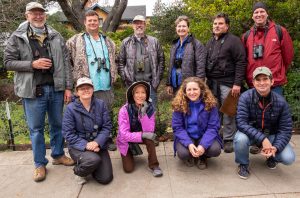
It turned out, though, that Dave had actually begun his own personal owl search earlier at 2AM. When he was scouting earlier in the week, he had noticed some dumpsters on Telegraph Avenue and thought that they probably attracted a lot of rats and hence they might be a good place to find a city owl. As he drove down Telegraph towards the dumpsters that morning, he thought he heard the distant shriek of a Barn Owl. He stuck his phone out the window, hit play on the Barn Owl call, and within seconds, one of them buzzed his car. The 2018 Oakland Christmas Bird Count was underway.

The owling in Claremont Canyon didn’t begin quite as auspiciously. At our first site, Dave played calls for both Western Screech Owls and Northern Saw-Whet Owls. Nothing. But things picked up at our second stop—nearby a male and female Western Screech Owl returned Dave’s greetings. And then further down the canyon two Great Horned Owls flew overhead. Things were looking promising.
The weather in particular was a worry. Heavy rain had been predicted for Sunday but so far the early morning remained dry and warmer than expected. After chasing down another Great Horned Owl at the top of Skyline Drive, we returned to our original meeting place at the Peet’s by the Claremont, made plans for the next couple of hours, and divided up into three teams. Since I had served as his scribe last year, Dave was happy to claim my services.
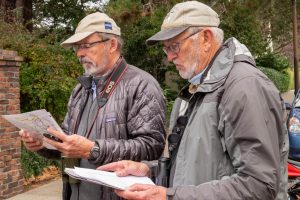
Leaving the coffee shop, Dave and I went over the hill to Lake Temescal. A year ago on the CBC, I had visited Lake Temescal with Dave and Bob Lewis, who had told me that almost a decade earlier they had been there around sunrise for the CBC and a large flock of roosting Red-winged Blackbirds had taken off en masse. They were surprised. Red-winged Blackbirds weren’t a bird they typically recorded in the Claremont Area. But since then they tried annually to visit Temescal around sunrise for the liftoff.
We got there about 7:10. The sun wasn’t up yet but it was nearly light. The only other people there were a few hopeful fishermen. Dave and I staked out the reed bed where the blackbirds roosted. We could hear some of them beginning to stir. But it didn’t seem like nearly as many as we had counted last year (we thought the previous count was 600 but when Dave checked later, it was 400—that’s a lot of blackbirds.) I was guessing there were maybe fifty birds in the reed bed. When they at last took off about 30 minutes later, Dave and I were poised at each end of the reed bed. When these birds finally decide to leave, they don’t hang around—the whole flock was gone in under a minute. Dave came striding toward me afterwards, and I asked him how many he had counted. “You first,” he said. I replied that I estimated the flock to be about 240 birds—much larger that I had initially thought, but small than last year. “How about you?” I asked. “Two hundred and fifty,” he said; “you missed ten of them.” It’s easy to see why I enjoy spending a day with Dave.

While at Temescal we also rounded up the usual lakeside suspects: a dozen or so Black-crowned Night Herons, American Coots, and Double-crested Cormorants, a few Mallards and Buffleheads, a couple Common Goldeneyes and California Gulls, and a solo Green Heron and Great Blue Heron. We were surprised to find no Pied-Billed Grebes, however. On the way back to rendezvous with the rest of our group, Dave wanted to make a quick stop just off Tunnel Road at the Firestorm Memorial Garden. He remembered a report that a Rufous-crowned Sparrow had been seen nearby a few weeks earlier. We only had a few minutes so Dave took the uphill side and I checked out the garden itself. The garden looked promising, but with the weather turning colder, wetter, and windier, the birds had clearly taken refuge elsewhere.
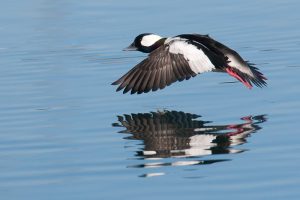
As I was preparing to give up, I caught the backside of a sparrow disappearing under some shrubbery. Dave had just crossed the street and I pointed out to him the spot where the bird had disappeared. I was sure it was lurking just out of sight and would reappear. We waited a couple of minutes and just as we were getting ready to leave the bird flew out of the bush and perched on a nearby twig. “What the heck is that?” Dave said as he got his glasses on it. Then he
was jumping up and down, high-fiving me: “Rufous-crowned Sparrow!” He was delighted that he had remembered the earlier scouting report—this would be the only one of its species our group would see that day. Then on the way back to the car, we ticked off a couple of Common Ravens.
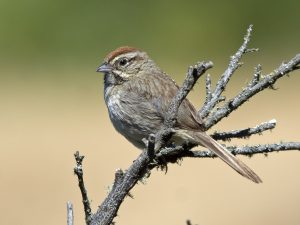
Back on The Uplands in Claremont we met up with our whole group—our previous companions and some new ones: Graham Chisholm, Cheryl Navares, Maria Sabatini, and Tan Suwannukul. We traded stories about the last couple of hours, including ours about the Rufous- crowned Sparrow (it’s amazing how much enthusiasm a little bird like this can generate at the CBC). A California Thrasher had also been seen. But the best story was Margaret’s who had seen a Bald Eagle fly right by her while she was up on the hilltop. Then Dave divvied up the day’s assignments and we split into four groups.
Dave and I headed up to the end of Chabot Road. The wind had picked up and there was a little bit of rain falling. I recalled that when we had birded this area last year, the day was dry and there was little wind—we had seen lots of warblers in the tall flowering eucalypts overhead. Today there were no warblers (we couldn’t even see any flowers on the eucalypts) and we completed a very quiet circuit. But driving back down Chabot things began to pick up. We pulled over for some cotoneasters covered in berries on a hillside and got a Northern Flicker and a Hermit Thrush. Then at the bottom of the hill we saw the flock of Cedar Waxwings at Chabot Field that Whitney Grover had told us she’d seen when she scouted the area earlier in the week.
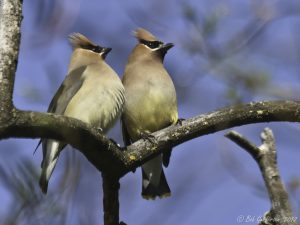
We parked a little further down Chabot Road and walked a few blocks in the neighborhood, checking especially for gardens with bird feeders. The wind was much quieter this far down the hill and the birding picked up. We saw Yellow-rumped Warblers, Ruby-crowned Kinglets, American Robins, White-crowned Sparrows, Oregon Juncos, California Towhees, Bushtits, and Lesser Goldfinches—in short, your usual assortment of Bay Area backyard birds in winter (except that we were seeing them in front yards.)
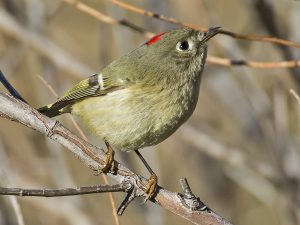
At noon we rendezvoused once again with the rest of our group—this time back at Lake Temescal. We compared notes to see how we were doing, using previous Claremont area counts to measure our progress. Many of the species historically seen on the CBC in our area were accounted for: Red-tailed Hawk, American Kestrel, Black and Say’s Phoebes, Downy, Nuttall’s and Hairy Woodpeckers, Hutton’s Vireo, Townsend’s Warbler, Mourning Dove, and Pygmy and Red-breasted Nuthatches. No Band-tailed Pigeons, though, and, surprisingly, no Eurasian Collared-Doves. Before we left Temescal, we had another look for the Pied Grebe but it was still AWOL. We did, however, get White-throated Swifts at the end of the lake.

We dispersed into teams again for the afternoon session, and Dave and I drove to an area in the Claremont Canyon that had burned in the 1991 fire. Dave said that in the years immediately following the burn it had been very good for birds who had flocked back to the new growth on the hillsides. But now the former small houses had all been replaced by much larger ones and there was less bird habitat than had been there previously. Additionally, the rain was really coming down now. We had been joined by Danielle Venton from KQED and her friend Ryan; Danielle was interviewing Dave about the Oakland CBC and its history for a piece she was doing. While Dave talked to Danielle I looked about—two American Robins and two California Scrub Jays. We were getting soaked, so we called it a day around 2 PM.
In the evening, more than 100 of the 279 people who had signed up for the Oakland CBC showed up for the dinner at the Northbrae Community Church in Berkeley. Of the eleven of us who had birded the Claremont area, five came to the dinner. Two of them—Dave and Bob Lewis as the event’s co-leaders—sat on the stage. I sat at a table with Margaret and Whitney. Their afternoons had been like mine—the rain interrupted the birding so they had added only a couple of new species to our collective area list: a Cooper’s Hawk and two White-throated Sparrows. (When Dave sent me his spreadsheet a couple of days later, our eleven observers had seen a total of 66 species and 1298 individual birds—with almost 20% of those being that flock of Red-winged Blackbirds!)
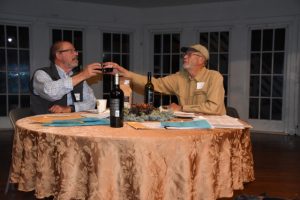
After dinner, Dave talked about the history and continuing importance of the Christmas Bird Counts, focusing in particular on what makes the Oakland count so special—for the past few years we’ve had more participants than any other CBC in the world. We also are among the top counts in the country in terms of the diversity of species counted, and we have the highest counts of some species (California Towhee, anyone?) anywhere in the world.
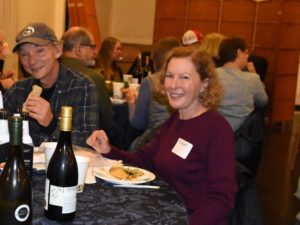
Next was my favorite part of the evening—a classic call and response. Bob Lewis would read out each name of the 163 species that have been seen in each of the last ten successive years, and anyone who had seen the species that day would yell out a loud “YES!” This is a quick—and fun—way to get an instant assessment of how successful the day has been. There were four species we had missed. For the second year in a row, no Loggerhead Shrike (though there is a report of one now living at the Oakland International Airport.) But no Lesser Scaups? Margaret whispered to me that if people could see hundreds of Greater Scaups, they hadn’t spent enough time checking them if they failed to turn up a single Lesser.
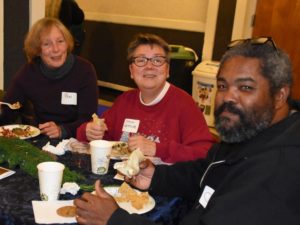
Finally, Bob finished up the evening by asking each of the 29 area leaders to give a brief account of their day. These accounts are inspirational as we hear about special birds seen, new folks joining the count, and the good times the participants had together. It also lets Bob and Dave get an unofficial sense of how the count stacked up against previous years—for instance, in 2016 a total of 179 species was recorded; that number was up by two last year, to 181.
Because we were down four species in the “regulars” count, we needed to pick up almost two dozen species if we were going to equal last year’s mark. We didn’t make it, but the stories from the different groups were so good that it almost didn’t matter. Bob told me afterwards that he thought the count had suffered from the weather (most teams knocked off shortly after lunchtime when the rain began to come on.) But the lower count didn’t dispel the holiday cheer of the people in the hall. Already, people were asking the date of next year’s count and making plans for early morning owling expeditions.
Go here to hear Danielle’s KQED interview with Dave.
GGBA Boardmember Eric Schroeder worked at UC Davis where he had a thirty-year career as a lecturer and administrator. His local volunteer work includes serving as president of the Tilden Wildcat Horseman’s Association for seven years and being a member of the East Bay Regional Park District’s Volunteer Mounted Patrol. He recently completed the Master Birder Program sponsored by GGBA and the Academy of Science.
